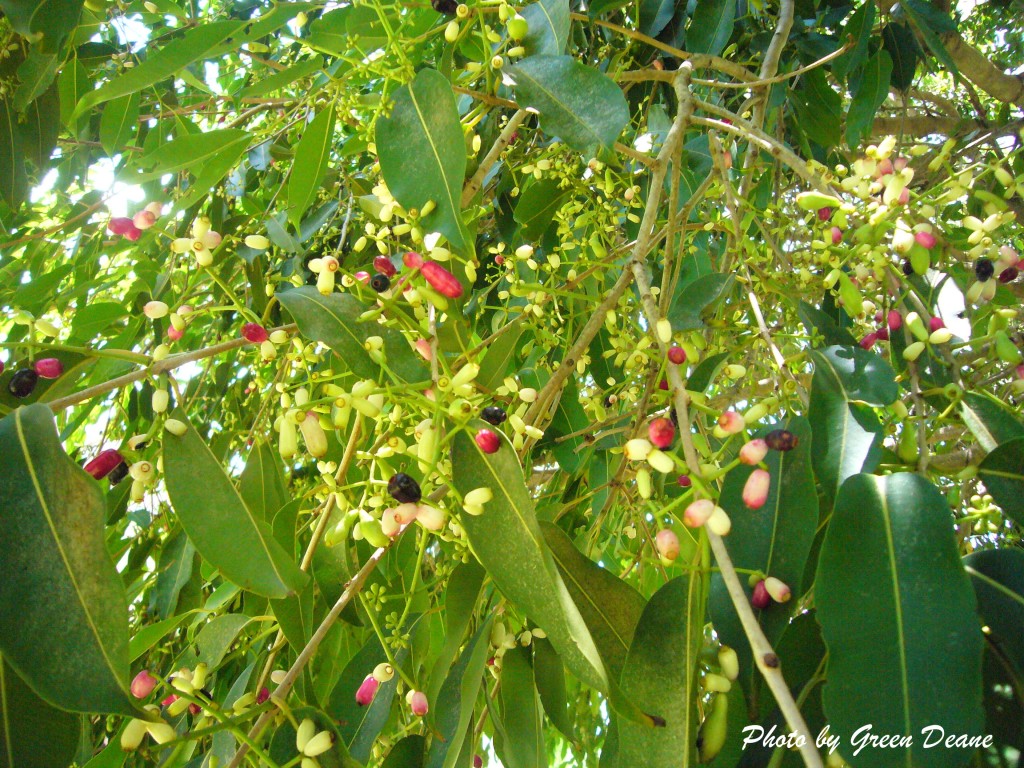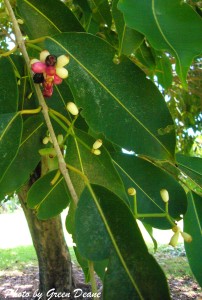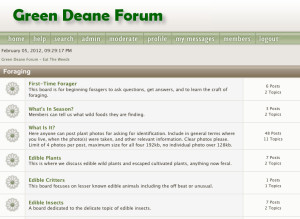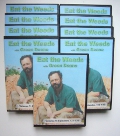One of the aspect of foraging in Florida is the length of the state, a situation Californians can also relate to. The zones range from temperate to tropical, Canadian plants on one end, Hawaiian on the other. This can make foraging fascinating and frustrating. It means a lot more plants to consider and you’re never quite sure what you’ll run into as in Dreher Park this past weekend in West Palm Beach.
The park was the work of Paul Dreher, a German immigrant between the world wars. He changed waste and swamp land into a large park. Though damaged by hurricanes a decade ago it is thriving and something of a treasure hunt. What did he plant, and where? And as it was to be a public park, I also suspect nothing toxic was allowed. When I first started holding classes at Dreher park I tried to find someone who knew what was planted there because the place is not small — 113 acres — and most of what’s growing there is by design. Finding no source I have just had to muddle through on my own visiting the park about once every six to eight weeks. Nearly every time I am there something new is in fruit. And so it was this past weekend.
Global warming might be an issue now but it was warmer locally decades ago. Old mango trees still survive the increasingly cool winters here in Central Florida only because they are old, big and well established. Getting a young mango to thrive here is a challenge. I have a star fruit growing in a microclime but it is easily now 50 miles north of its zone. And locally there is one Jambul tree, found by my friend Marabou Thomas. I’ve never seen it fruit. I suspect it will be a victim of the cooler weather as well. Thus it was a pleasant surprise to find one in fruit in Dreher Park.
It was a tree I have walked by several times over the past few years but not at just the right time. And as it is a tree I am not hugely familiar with I was cautious at first. Fortunately, one of the students in the class, Robert Dagit, thought he recognized it and thus I became the student for a while, which I like because its fun. Not only are the fruit edible but a close relative provides us with nutmeg and mace. To read more about the Jambul tree go here.
The email recently brought a comment from a reader who said he couldn’t find purslane (Portulaca oleracea.) My first thought was it grows everywhere… which is not helpful. In fact just this past week someone wanted me to bring some purslane to a foraging class. So on the morning of the class I was looking for some. Where do I look to find purslane? In suburbia I look around landscaping, particularly hedges and edges of lawns. Unattended berms are good as is unmown areas around landscaping trees, such as in city parks. Flowerbeds and gardens also usually have a plant or two. You can also find purslane at stop signs and the like, even sidewalk cracks (which is where I got mine that has been reseeding itself for some 14 years. ) Look for niches and disturbed soil. That’s where purslane likes to grow.
Upcoming foraging classes: Sunday, June 29th, Bayshore Live Oak Park, 23000 Bayshore Rd., Port Charlotte, FL 33980, 9 a.m.; Saturday, July 12th, Mead Garden,1500 S. Denning Dr., Winter Park, FL 32789, 9 a.m.; Sunday, July 13th, Florida State College, south campus, 11901 Beach Blvd., Jacksonville, 32246, 9 a.m. For more information about upcoming classes go here.
On the Green Deane Forum we post messages and pictures about foraging all year long. There’s also a UFO page, for Unidentified Flowering Objects so plants can be identified. Recent topics include: Help Me ID a Few Plants/Weeds; Need Help With These Too; Different Pinus Sap; Garlic, The Medicine of Longevity; Lots of New Plants; Sugar Pine Chewing Gum, Making my own Camphor, Bee Balm, What Is Your Favorite Flower To Eat? The link to join is on the right hand side of this page.
My foraging videos do not include alligators but they do cover dozens of edible plants in North America. The set has nine DVD. Each DVD has 15 videos for 135 in all. Some of these videos are of better quality than my free ones on the Internet. They are the same videos but many people like to have their own copy. I burn and compile the sets myself so if you have any issues I handle it. There are no middle foragers. And I’m working on adding a tenth DVD. To learn more about the DVDs or to order them click here.
 Because this site gets some 11 million hits a month it has to be moved to its own server. This will include some graphic changes and as we noticed this past week some minor irritations such as the search button disappearing (temporarily, even I use it.) Also because of the holiday, a bit of a vacation, and a one year In Memoriam, there will be no newsletter July 1st.
Because this site gets some 11 million hits a month it has to be moved to its own server. This will include some graphic changes and as we noticed this past week some minor irritations such as the search button disappearing (temporarily, even I use it.) Also because of the holiday, a bit of a vacation, and a one year In Memoriam, there will be no newsletter July 1st.








The very edible (or so I’ve read) Hypochaeris radicata (sometimes spelled Hypochoeris radicata), also known as flatweed or false dandelion is EVERYWHERE in North Georgia this year. It covers vast fields, roadsides, lawns, etc. Sometimes it runs along the side of a rural road for miles. Cut it and it pops right back up. I’m also now seeing Johnson grass in places I’ve never seen it before. Last year was exceedingly wet in Georgia — over 66 inches, the fifth wettest ever. Do you think the extra rain brought about this transformation of the landscape?
I have an article on false dandelions on this site. As for rain and Johnson Grass… I somehow remember extra rain is supposed to increase the amount of cyanide in that grass.
Regarding Dreher park. I lived here some 35 years ago, moved away and then back. On the first trip there was a guide to the park printed on copy paper with crude cut and paste. It was done by a local garden club I think , maybe even the 4-arts. Anyway, it was fairly comprehensive and looked a bit like dick deurlings guide, listing the species and their proximity to one of the parks landmarks, then one would go out and look for it. I, at the time was fresh from the northeast and facinated by the park. I only wish I had kept half the stuff I had back then. I mention this because there may be a dusty copy in someones shelf somewhere in a garden club somewhere. Also, Mounts may have something for you? Couldn’t hurt. Speaking of mounts, saw a candlefruit tree in full fruit there about 2 weeks ago, along with several cactus pears, made my mouth water.
Interesting. Re the candlefruit tree… was in in the southern section, east side, about a quarter mile down near where a road comes in from the east?
Green Purslane can be found in Baker creek Heirloom Seeds http://www.rareseeds.com 417-924-8917
Often, whenever we need to cook purslane, I don’t have to go to the vegetable market or a nearby grocery. I have just to collect this from my flower pots, flower beds, and even between “ the jig saw- like pattern of the red mud bricks that make the floor of my house courtyard . Because my wife who is responsible for cooking is in bad terms with wild purslane, I usually prepare, by washing and cutting the amount needed in the final form required to add to the cooking pot. Usually as such it will be indistinguishable to any body including my wife regarding wild and tamed purslane.
Once I asked a seed shop owner to get me a gram of purslane seeds as I have a very small area to plant. He looked me down with some resentment as his customers are whole sale buyers. Fortunately just round the corner and a few yards from the door’s shop (in Khartoum North) I found a gathering of purslane plants some blossoming with shining yellow flowers and others giving seeds. As all stems are stern and upright I was convinced to take them home.
In mid April this same year, I pulled gently a bundle of growing stems of purslane plant with roots still holding not much tiny grains of soil. Nearly two weeks passed over and still part of these plants were existing – green and vivid; is’nt that wonderful! Life is great.
Hi Deane,
Enjoy your vacation- well deserved. And a continual thank you for your great articles!
I was shopping at Lowes in Gautier, MS last spring and they were selling gallon size containers of Purslane for about seven bucks. I thought this was very strange because my garden of domestic and wild vegitables is inundated with Purslane. My friends have often asked why I don’t weed my garden and I tell them that I do, but only the non useable weeds and grasses and I leave the purslane and explain why. It is like another crop because it is so well established and I use it as a pot herb, in stir fries and salads,and still I have enough Purslane to share. Earlier in the spring Henbet, chiskweed and wild garlic were throughout the garden plot. I think the reason I have so many wild edibles is because of my concern for the soil and I grow in an organic manner. Light tilling for one thing. I have found that you don’t have to bombard the soil with too much cultivating. I also read in Mother Earth News one time that certain good strings run between all plants (I do not remember what they called these strings) and all plants are connected harmoniously. When we deep-till the soil these strings are torn and affect the growth patterns of that soil. I am also very careful with chemical use and have proved that domestic and wild edibles can exist together in a harmony if treated with respect. By the way, it took the soil several years after hurricane Katrina hit this area for the soil to purge the salt water that flooded this coastal area, but the soil has come back and my garden and others in the area, including Nature’s garden have come back dramatically. I grew up in your area of central Florida and I remember after hurricane Donna flooded the area in 1960, it took several years for growth patterns to reestablish themselves. Even though hurricanes are the great cleansor, their affects on the soil and native plants can last quite a while.
So right; Chaz Mikell. We here in north borneo have started a project called, ‘to earth with love’ where the stress is in the organic and connected way plants, insects etc keep the environment healthy and we can forage on a daily basis. Eswari